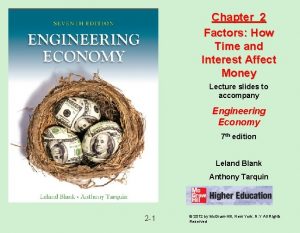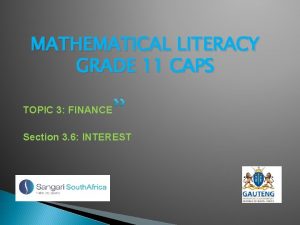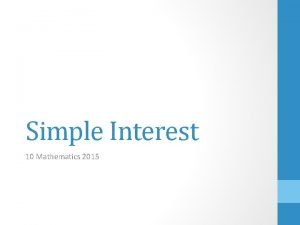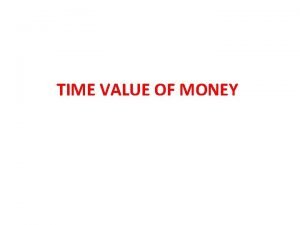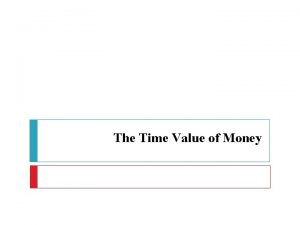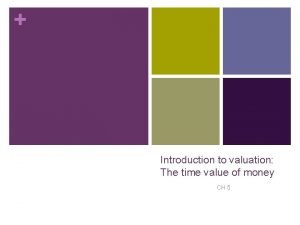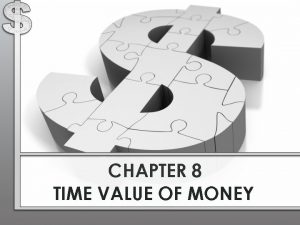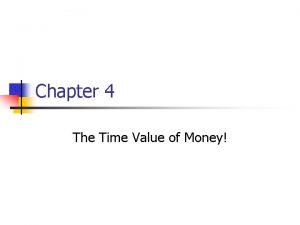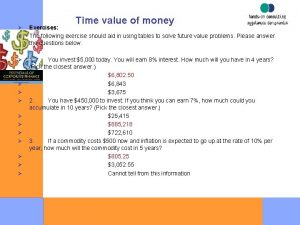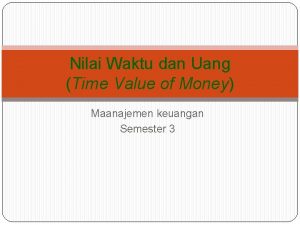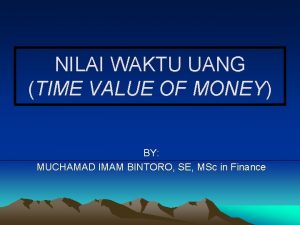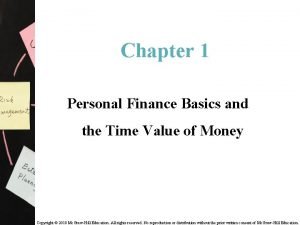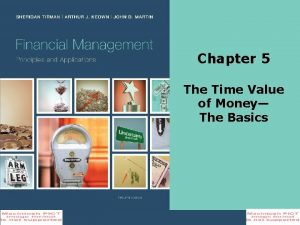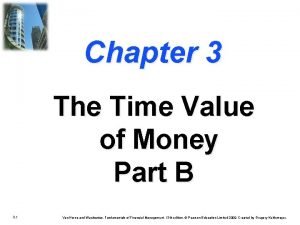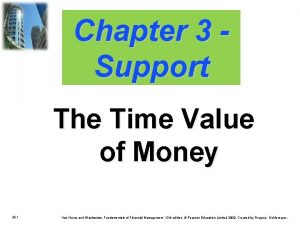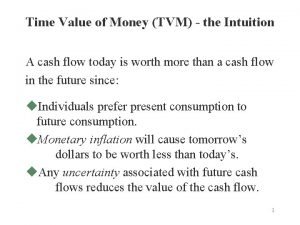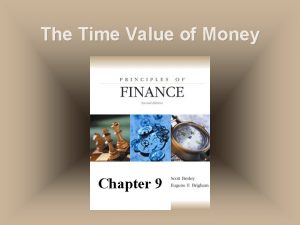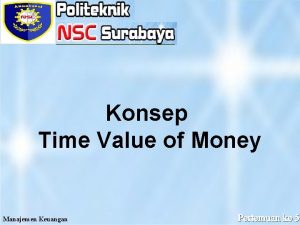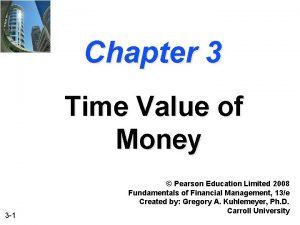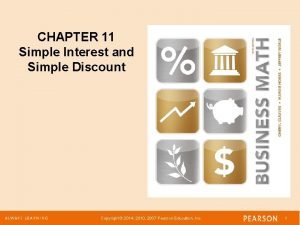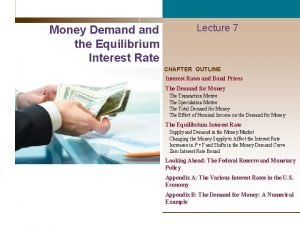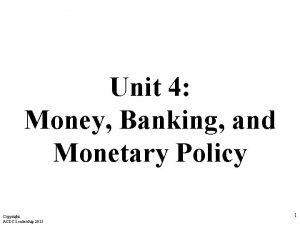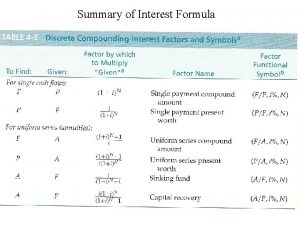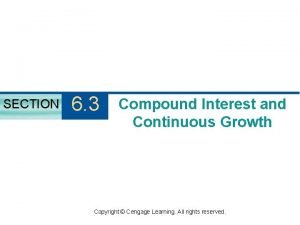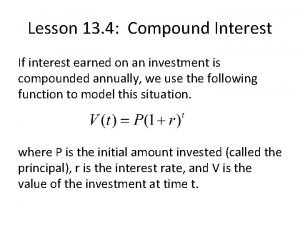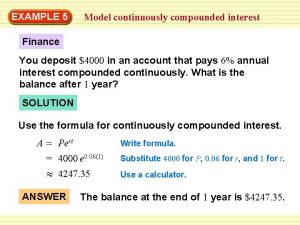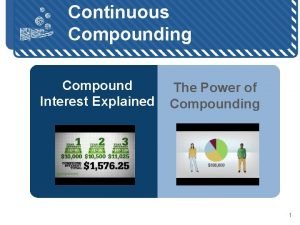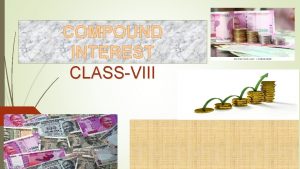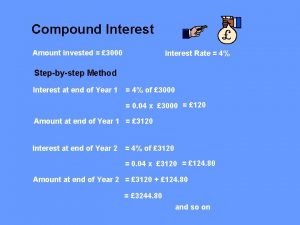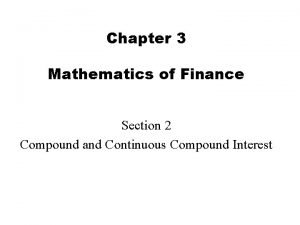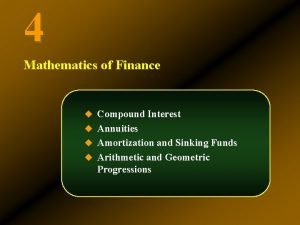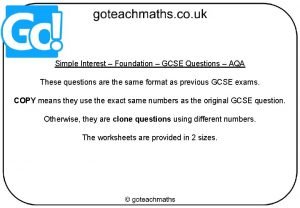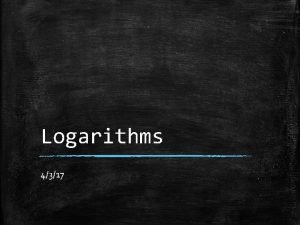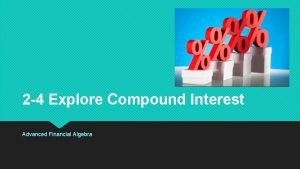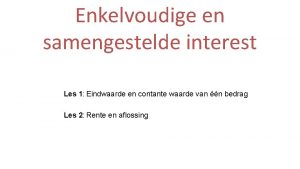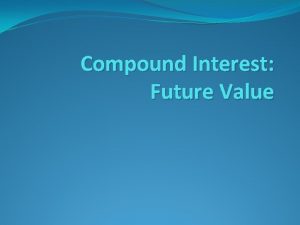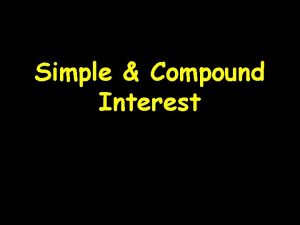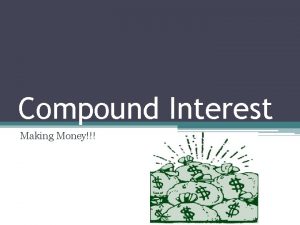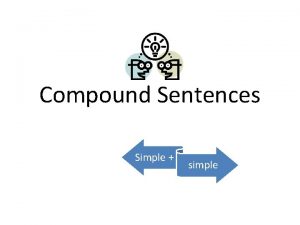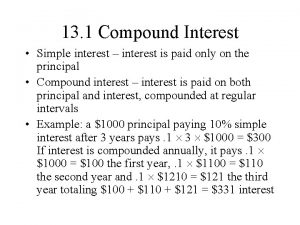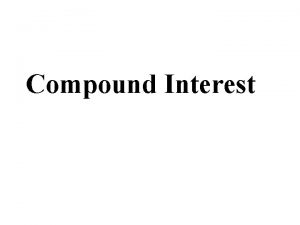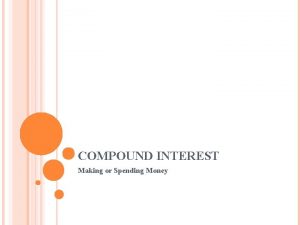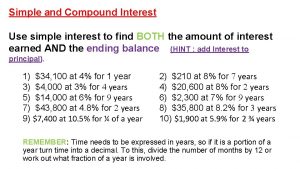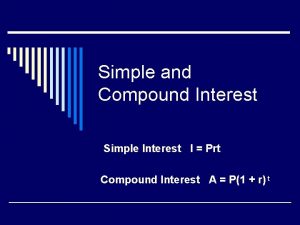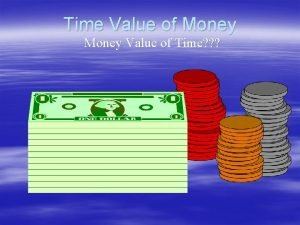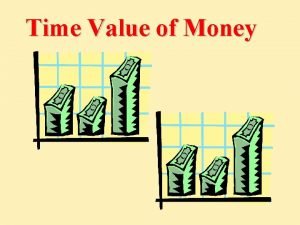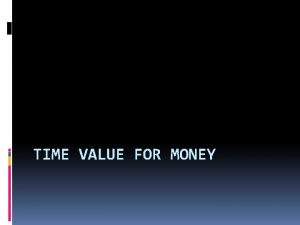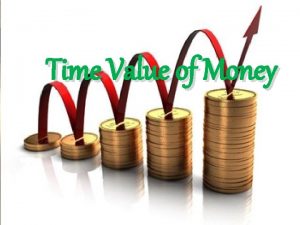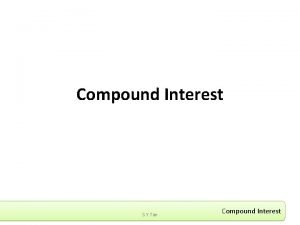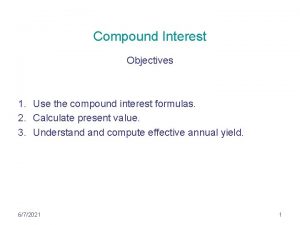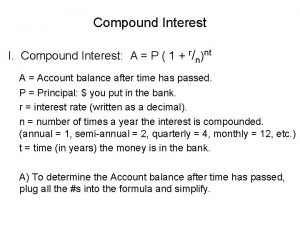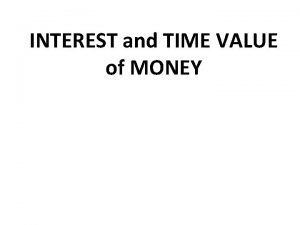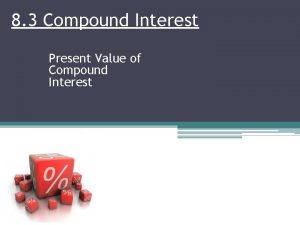Simple interest Compound Interests Time Value of Money

















































- Slides: 49

Simple interest, Compound Interests & Time Value of Money Lesson 1 – Simple Interest 1

The Concept of Interest • When you deposit money into a savings account at a bank you expect the bank to pay you additional money on top of your saving. The extra money is called interest. • Interest is also paid by a borrower to a lender for the loan borrowed. • There are two methods to calculate interest: • Simple interest • Compound interest 2

Simple Interest Formula • The simple interest (I) is calculated as: • Principal x Interest Rate x Time • We can use short form to interpret this: I = P x r x t • P = Principal (amount invested or borrowed) • r = Interest rate (per annum) • t = time (measured in years or converted to years by dividing by 12 months) I=Pxrxt 3

Simple Interest Formula – Example • You have $10, 000 in a savings account that pays 3% simple interest per annum. a) How much interest will you earn in 2 years? b) How much interest will you earn if you withdraw the money after 9 months? 4

Simple Interest Formula – Example (Solutions) a) Interest = $10, 000 x 3% x 2 = $600 b) Interest = $10, 000 x 3% x 9/12 = $225 5

Activity 1 – Find the Principal Amount Invested • What is the amount of principal that gives an interest of $3, 000 in 4 years at 5% simple interest? 6

Activity 1 – Find the Principal Amount Invested I = $3, 000, r = 5%, I=Pxrxt $3, 000 = P x 5% x 4 P = $3, 000 ÷ 5% ÷ 4 = $15, 000 t=4 7

Borrowing and Repayment • You have bought some goods from a shop at $8, 000 on credit. The interest rate charged by the shop is 14% per annum. • How much will you have to pay to the shop after 6 months? 8

Borrowing and Repayment • Answer: • $8, 000 + ($8, 000 x 14% x 6/12) = $8, 560 9

Discount • The simple interest formula can also help you calculate the money you are actually spending when the shop is offering discount on the goods. • For example, your favourite brand fashion is on sale for 20% off the regular price. You find the T-shirt you like at a price of $380 originally. • What is the amount of the discount? • What is the sale price? 10

Discount • Answer: • Discount = $380 x 20% = $76 • Sale price = $380 - $76 = $304 or $380 x (1 – 20%) = $304 11

Simple interest calculation • Banks are currently paying an interest rate of 6% per year on deposits. • Using simple interest calculation, how much you can get after one year if you deposit $1, 000 into the bank? How about after 5 years? 12

Simple interest calculation Example - Simple Interest earned at a rate of 6% for five years on a principal balance of $1, 000. Year Balance at the start of year Interest earned during year Balance at the end of year 1 $1, 000 $60 $1, 060 2 $1, 060 $1, 120 3 $1, 120 $60 $1, 180 4 $1, 180 $60 $1, 240 5 $1, 240 $60 $1, 300 13

Financial Products Using Simple Interest • Bonds/debentures • Interest is calculated based on the face value of the bonds and normally paid half-yearly. • i. e. if the face value of a bond is $10, 000, interest rate is 5% per annum. Then interest for the every six months = • $10, 000 x 5% x 6/12 = $250 • i. Bond is different as the interest rate is not fixed. • Its interest rate is varied for each payment and is linked with the Consumer Price Index (CPI). • However, it is still using simple interest calculation. 14

Activity 2 – Exercise • Your elder brother invested $50, 000 in bonds for 2 years at interest rate of 6% per annum. How much interest has he earned if the interest is paid annually, and what is the balance in his account? 15

Activity 2 – Answer • Your elder brother invested $50, 000 in bonds for 2 years at interest rate of 6% per annum. How much interest has he earned if the interest is paid annually, and what is the balance in his account? P = $50, 000, r = 6%, t=2 Interest = $50, 000 x 6% x 2 = $6, 000 Balance = $50, 000 + $6, 000 = $56, 000 16

The End 17

Simple interest, Compound Interests & Time Value of Money Lesson 2 – Compound Interest 1

Compound Interest • The usual commercial procedure for dealing with interest earned is to add it to the investment at the end of each interest period. • i. e. Re-investing your interest income from an investment makes your money grow faster over time! • This system of adding interest to the investment is called a compound interest system. • Compound interest uses the same information as simple interest, but what is new is the frequency of compounding n. 2

Simple Interest vs Compound Interest • Simple interest – interest is paid only on the principal • Compound interest – interest is paid on both principal and interest, compounded at regular intervals 3

Calculation of Compound Interest • Let us begin our analysis by considering a sum of $1, 000 invested at 10% per annum over a five-year period. It is easiest to tabulate the calculation as below: 4

Activity 1 • Banks are currently paying an interest rate of 6% per year on deposits. • Using compound interest calculation, how much can you get after one year if you deposit $1, 000 into the bank? How about after 5 years? 5

Activity 1 – Answers Example – Compound Interest earned at a rate of 6% for five years on a previous year outstanding balance. Year Balance at the start of year Interest earned during year Balance at the end of year 1 $1, 000 $60 $1, 060 2 $1, 060 $63. 6 $1, 123. 6 3 $1, 123. 6 $67. 42 $1, 191. 02 4 $1, 191. 02 $71. 46 $1, 262. 48 5 $1, 262. 48 $75. 75 $1, 338. 23 6

Results as Series We can now summarise the results so far as Sum at the end of period 1 Sum at the end of period 2 Sum at the end of period 3 Sum at the end of period 4 Sum at the end of period 5 = = = P(1 + r)2 P(1 + r)3 P(1 + r)4 P(1 + r)5 7

General Equation • We can write down the general result which will give the sum invested, A, by the end of period n, as A = P(1 + r)n 8

Example Let us now return to our original problem of investing $1, 000 at 10% pa for 5 years. In our general terminology we have here that P = 1, 000, r = 0. 1, n=5 and wish to find A. Substituting these numbers into our formula we have A = 1, 000(1 + 0. 1)5 = 1, 000(1. 1)5 The calculation can now be completed using your calculator, to give A = $1, 610. 51 9

Daily and Continuous Compounding • Daily compound interest formula: divide r by 365 and multiply n by 365 10

Daily and Continuous Compounding • Example: Find the compound amount if $5, 000 is deposited at 5% interest for 10 years if interest is compounded daily. 11

Summary • Under the compound interest calculation, the amount is larger due to the power of interest on interest. • In finance, compound interest calculation is implicitly assumed. That is, interest or return on investment earned will be re-invested at the interest rate assumed. 12

Present Value of a Future Sum • Your uncle has give you a sum of $1, 000 but you are not to receive the money until you have reached the age of 28 (15 years later). However, you would like to have the money now so you consult your bank manager. He is willing to buy your fund now, but the problem is what it is worth today. 13

Present Value • It is known that the sum of $1, 000 is guaranteed in 15 years and a fixed interest rate of 3. 5% p. a. over the 15 years is assumed. The sum that he should give you now is called the present value of the future sum. If this sum of money is invested for 15 years at 3. 5% p. a. , it would amount to $1, 000. In our previous notation we have A = 1, 000 r = 0. 035 n = 15 14

Present Value We wish to find P. Using the compound interest formula, we have 1, 000 = P(1 + 0. 035)15 or, on transposing or solving this equation for P 1, 000 P= = $596, 891 (1. 035)15 15

Generalising This means that the present value of $1, 000 payable in 15 years with a fixed interest rate of 3. 5% is $596, 891. This is the sum that the bank manager should be offering to you. In general, the present value of a sum A payable after n periods with a rate r period is given by P= A (1 + r)n 16

The End 17

Simple interest, Compound Interests & Time Value of Money Lesson 3 – Time Value of Money 1

Let’s discuss: • One dollar today is worth more than one dollar in the future, say 1 year later. Why? One year later 2

Reason • • The reason is simple. If you get $1, 000 today, you can deposit the money into the bank and earn the interest over 1 year. After 1 year, your wealth is, for sure, more than $1, 000. Thus, compared with getting $1, 000 in one year, getting $1, 000 today is worth more! Suppose the annual interest rate is 6% and you are asked to give up $1, 000 now. How much will you require to get back in one year to break even? 3

Future Value • What is Future Value? • Future value is the value of a present amount at a future date, found by applying compound interest over a specified period of time. • In the above example, $1, 060 is the 1 year’s future value of $1, 000 now [$1, 000 x (1 + 6%)]. $1, 338. 2 is the 5 year’s future value of $1, 000 now [$1, 000 x (1 + 6%)5]. • If the principal is fixed at $1, 000, what is the general formula of the T-year’s future value? 4

Future Value of the principal of $1, 000 = FV • What does the future value depend on? 1. Number of years of investment, t 2. The interest rate, r 3. The principal amount, $1, 000 • The larger the above three values, the larger the future value is. 5

Future Value of $1 90 80 Future Value of $1 70 60 50 40 30 20 10 0 2 4 6 8 10 12 14 Periods 0% 5% 10% 15% 16 18 20 22 24 20% 6

How can we find the future value? 1. 2. 3. 4. Using scientific calculator Using future value table Using financial calculator Using excel 7

Present Value • • • The above questions can be asked in another way. If we want to have a certain sum of money in the future, say at the end of five years, given a certain interest rate, how much should we save today? This is one of the examples of present value calculation. Present value is the current dollar value of a future amount; the amount of money that would have to be invested today at a given interest rate over a specified period to equal the future amount. The process of finding present values or the inverse of compounding interest is called discounting cash flows. The interest rate used in converting future value into present value is called the discount rate. 1/(1+r)t is known as the discount factor. 8

Present Value • The relationship between the present value and future value can be shown by the following formula: is the discounting factor or present value interest factor. 9

Time Value Terminology Denoted on a Timeline • Consider the time line below: 0 PV 1 2 3 4 … t FV • PV is the Present Value, that is, the value today. • FV is the Future Value, or the value at a future date. • The number of time periods between the Present Value and the Future Value is represented by “t”. • The rate of interest is called “r”. • All time value questions involve the four values above: PV, FV, r, and t. Given three of them, it is always possible to calculate the fourth. 10

What does the present value depend on? 1. The larger the discount rate, the lower the present value is. This property is very important in finance as it can explain why when the interest rate goes up, usually the asset prices fall. 2. The larger the t, the lower the present value is. The present value of more distant cash flows is worth less. 3. The larger the future value, the higher the present value is. 11

Present Values with Compounding 1. 2 Present Value of $1 1 0. 8 0. 6 0. 4 0. 2 0 2 4 6 8 0% 10 5% 12 14 Periods 10% 15% 16 18 20 22 24 20% 12

Activity 1 – Making Decision by Using the Concept of Time Value of Money Your auto dealer gives you the choices of paying $155, 000 by cash now, or making three payments: $80, 000 now and $40, 000 at the end of the following two years. If the interest rate is 8%, which method do you prefer? 13

Activity 1 – Answer • Present values can be added together to evaluate multiple cash flows. • PV (by instalment) = $80, 000/(1. 08)0 + $40, 000/(1. 08)1 + $40, 000/(1. 08) 2 = $151, 331 • PV (full payment) = $155, 000 • Which method do you prefer? 14

The End 15
 Simple interest
Simple interest Money money money team
Money money money team How time and interest affect money
How time and interest affect money Maths literacy grade 11 finance questions
Maths literacy grade 11 finance questions Characteristics of a lyric poem
Characteristics of a lyric poem Simple interest
Simple interest Simple and compound interest practice worksheet answer key
Simple and compound interest practice worksheet answer key Simple interest maths
Simple interest maths Question about free time activities
Question about free time activities What can you do in your free time
What can you do in your free time Pauline and bruno have a big argument
Pauline and bruno have a big argument Simple, compound-complex rules
Simple, compound-complex rules Tvom
Tvom Learning objectives of money
Learning objectives of money Introduction to valuation the time value of money
Introduction to valuation the time value of money Chapter 8 time value of money answer key
Chapter 8 time value of money answer key Time value of money quiz
Time value of money quiz Time value of money exercises
Time value of money exercises Anuitas adalah
Anuitas adalah Diskusi tentang time value of money
Diskusi tentang time value of money Personal finance basics and the time value of money
Personal finance basics and the time value of money Time value of money
Time value of money Firmilate
Firmilate Chapter 3 time value of money problem solutions
Chapter 3 time value of money problem solutions Time value of money
Time value of money Chapter 2 time value of money solutions
Chapter 2 time value of money solutions Pengertian time value of money
Pengertian time value of money Chapter 3 time value of money problem solutions
Chapter 3 time value of money problem solutions Penciptaan nilai adalah
Penciptaan nilai adalah Rate of discount formula
Rate of discount formula Simple discount rate formula
Simple discount rate formula Nominal v. real interest rates
Nominal v. real interest rates Effective rate
Effective rate Money demand and interest rate
Money demand and interest rate Money supply and interest rate
Money supply and interest rate Discrete compounding formula
Discrete compounding formula Compound interest vocabulary
Compound interest vocabulary Compound interest problem example
Compound interest problem example Lesson 13 4 compound interest answers
Lesson 13 4 compound interest answers A=pert formula
A=pert formula What is compounded continuously
What is compounded continuously Objectives of simple interest
Objectives of simple interest Compound interest steps
Compound interest steps Example of annual percentage rate
Example of annual percentage rate Compound interest problem example
Compound interest problem example Simple interest questions gcse
Simple interest questions gcse Log base desmos
Log base desmos 2-4 explore compound interest
2-4 explore compound interest Society and culture pip
Society and culture pip Compound interest berekenen
Compound interest berekenen


